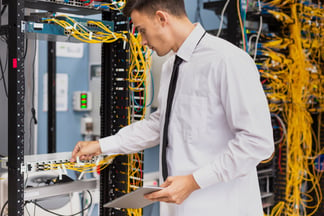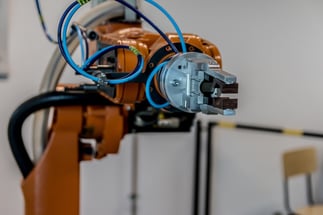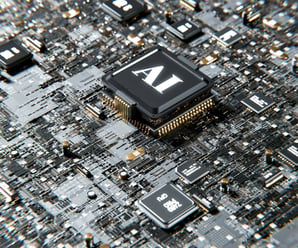The transportation sector is a critical component of global supply chains, influencing everything from raw material sourcing to final product delivery. Yet, as supply chains grow more complex and span across shipping, logistics and distribution, it’s often plagued by inefficiencies that can lead to increased costs, delayed deliveries, negative environmental impacts and decreased customer satisfaction.
Fortunately, the advent of cutting-edge technologies like artificial intelligence (AI), the Internet of Things (IoT) and the cloud is revolutionizing how we think about and manage transportation. These promising solutions can drive significant improvements in performance, optimization, efficiency and sustainability.
Let’s explore how technology is reshaping transportation and driving operational improvements.
Read: Robots, Drones, AI – Oh, MY! Innovative Technologies for Construction
The Importance of IT Infrastructure in Modern Transportation
A well-designed IT infrastructure forms the foundation for integrating various transportation systems within the supply chain. Whether managing air cargo, shipping goods via boat or optimizing logistics for ground transportation, the ability to connect, communicate and share data seamlessly is critical.
- Data management: Modern IT systems allow businesses to collect, store and analyze data, providing real-time visibility across various modes of transportation. By integrating with enterprise resource planning (ERP) systems and other business platforms, companies can monitor everything from shipment tracking to fleet performance, enabling informed decision-making.
- Improved communication and collaboration: With robust communication tools built into IT systems, different stakeholders, such as manufacturers, suppliers and logistics providers, can collaborate in real-time. This streamlines decision-making, reducing bottlenecks and improving response times when disruptions occur in transit.
- Security and compliance: Advanced IT solutions ensure that sensitive transportation data, including shipment manifests, client data and financial transactions, remains secure. These systems also help companies stay compliant with regulatory requirements, including customs and transportation laws, as well as maintain operational continuity and prevent disruptions and cyber attacks.
Automation Reduces Human Error and Increases Speed
Automation is playing a transformative role in improving the speed and accuracy of transportation in supply chains. Automated systems can manage everything from warehouse operations to transportation scheduling, minimizing human error, raising production levels and accelerating the movement of goods.
- Automated warehouses: Automated picking and packing systems in warehouses allow goods to be loaded for transport with minimal delay, reducing lead times and improving efficient inventory management.
- Scheduling and route automation: Automated route-planning software helps optimize delivery schedules by analyzing traffic, weather and delivery time windows. In logistics and shipping, these automated systems reduce manual intervention and enhance decision-making to ensure that goods are transported along the most efficient routes, minimizing fuel consumption and travel time.
- Autonomous vehicles: Although autonomous vehicles are still in development, they have the potential to revolutionize transportation by reducing human error and improving efficiency. They can operate 24/7 and reduce delivery times, labor costs and human error, all while improving road safety.
Artificial Intelligence and the Internet of Things Optimize Transportation
Although AI and the IoT are often highlighted as game-changers in transportation, they are most effective when integrated with broader IT systems and connecting different components of the supply chain together. These technologies provide specific advantages for improving transportation processes, empowering companies to make data-driven decisions and optimize operations.
- Predictive analytics: AI can analyze vast amounts of historical data to predict future trends and demand, enabling proactive planning and minimizing disruptions. It can also monitor equipment health to prevent breakdowns, lower repair costs and reduce downtime.
- Fleet management: For transportation companies, efficient fleet operations are crucial. IoT sensors installed on vehicles, ships and aircraft provide real-time data on performance metrics such as fuel usage, driver behavior and route efficiency. This allows companies to make data-driven decisions about vehicle utilization and maintenance needs, keeping their transportation networks running smoothly.
- Real-time tracking: IoT devices provide unprecedented visibility into the supply chain. Sensors and trackers on shipments and vehicles offer real-time data on the location and status of shipments, vehicles and assets, enabling better tracking and route optimization.
Cloud Technology Enhances Logistics
Cloud-based solutions are also transforming transportation logistics, providing scalable and flexible systems that can handle the growing complexity of global supply chains.
- Scalability for growing operations: Cloud platforms allow companies to scale up or down based on their transportation needs, whether handling seasonal peaks or expanding to new markets. These systems offer the flexibility needed to manage diverse transportation networks, from small trucking fleets to large-scale shipping operations.
- Cost-efficiency: Cloud-based IT infrastructure reduces the need for expensive, on-premise hardware while providing real-time access to data from any location. This makes it easier for companies to manage and track their transportation systems, particularly for multinational operations.
Read: Unravel the Potential of Blockchain Technology
Benefits of Technology-Driven Transportation
By leveraging technology, businesses in the transportation sector can achieve significant benefits, including:
- Reduced costs: By minimizing fuel consumption, reducing maintenance costs, optimizing routes and reducing downtime, technology can lead to substantial cost savings.
- Improved efficiency: Optimized routes, reduced downtime and enhanced visibility lead to improved operational efficiency, streamlined operations and faster delivery times.
- Enhanced customer satisfaction: Real-time tracking and efficient delivery systems lead to faster, more reliable service, boosting customer satisfaction and loyalty. Customers can also receive accurate and timely updates on their orders.
- Increased sustainability: Technology can help reduce carbon emissions, fuel consumption and environmental impact through more efficient transportation practices.
- Data-driven decision-making: Big Data analytics, data-driven insights and predictive analytics can support informed decision-making and proactive problem-solving.
How Thriveon Can Help
Whether you’re managing logistics by air, land or sea, adopting the right technology will streamline your operations, reduce costs and help you stay competitive in the fast-evolving world of global supply chains. That’s where Thriveon comes into play.
We understand the importance of embracing these innovations and staying aware of the latest developments. That’s why we offer guidance and support in adopting these technologies and reaping their many benefits. As technology continues to evolve, expect to see more groundbreaking advancements that will further transform the transportation landscape.
Schedule a meeting now for more information.

